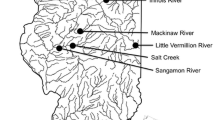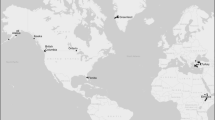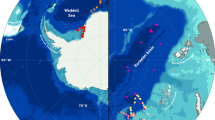Abstract
Use of tidal-freshwater and oligohaline wetlands by centrarchid fishes along a coastal river-estuarine gradient is partially controlled by salinity. I examined length-weight relationships between tidal-freshwater and oligohaline populations ofMicropterus salmoides, M. punctulatus, Lepomis microlophus, L. punctatus andL. macrochirus, species that commonly use saline wetlands. Analysis of covariance (ANCOVA) documented significantly heavier specimens ofMicropterus salmoides andLepomis microlophus in tidal-freshwater (P<0.05) than oligohaline marshes, whereas specimens ofL. punctatus showed no detectable differences (P>0.05) in length-weight patterns. Specimens ofL. macrochirus andM. punctulatus were heavier at a given length in tidal-freshwater than oligohaline marshes, but direct comparisons were not possible because of violation of the parallel slope assumption of ANCOVA. Data on some species examined contradict previous laboratory physiological data which suggested that salinity and its rate of change control use of saline habitats by centrarchids. These data support the hypothesis that use of habitat is a multidimension function of abiotic and biotic factors and that laboratory physiological studies based on abiotic factors alone may not provide all the answers to questions centered around life-history consequences of using various habitats.
Similar content being viewed by others
Literature Cited
Eccles, D.H. 1985. The effect of temperature and mass on routine oxygen consumption in the South African cyprinid fishBarbus aeneus Burchell. Journal of Fish Biology 27: 155–165.
Felley, J.D. 1987. Nekton assemblages of three tributaries to the Calcasieu Estuary, Louisiana. Estuaries 10: 321–329.
Fish, P.A. and J. Savitz. 1983. Variations in home ranges of largemouth bass, yellow perch, bluegills, and pumpkinseeds in an Illinois lake. Transactions of the American Fisheries Society 112: 147–153.
Furspan, P., H.D. Prange, and L. Greenwald. 1984. Energetics and osmoregulation in the catfish,Ictalurus nebulosus andI. punctatus. Comparative Biochemistry and Physiology 77A: 773–778.
Guier, C.R., W.G. Miller, A.W. Mullis, and L.E. Nichols. 1978. Comparison of growth rates and abundance of largemouth bass in selected North Carolina coastal rivers. Proceedings of the Annual Conference of the Southeastern Association of Fish & Wildlife Agencies 32: 391–400.
Hackney, C.T. and A.A. de la Cruz. 1981. Some notes on the macrofauna of an oligohaline tidal creek in Mississippi. Bulletin of Marine Science 31:658–661.
Halleman, E.M., R.B. Reed, W.H. Tucker, and R.A. Dunham. 1986. Biochemical genetics of largemouth bass in mesohaline and freshwater areas of the Alabama River system. Transactions of the American Fisheries Society 115: 15–20.
Hastings, R.E., D.A. Turner, and R.G. Thomas. 1987. The fish fauna of Lake Maurepas, an oligohaline part of the Lake Pontchartrain estuary. Northeast Gulf Science 9: 89–98.
Lorio, W., J.L. Underwood, W.D. Hubbard, and J.R. Herring. 1982. Life history of largemouth bass (Micropterus salmoides) found in Mississippi coastal marshes. D-J Project F-53 Completion Report, Mississippi Department of Wildlife Conservation, Jackson, MS, USA.
Meador, M.R. and W.E. Kelso. 1989. Behavior and movements of largemouth bass in response to salinity. Transactions of the American Fisheries Society 118: 409–415.
Meador, M.R. and W.E. Kelso. 1990a. Physiological responses of largemouth bass,Micropterus salmoides, exposed to salinity. Canadian Journal of Fisheries and Aquatic Science 47: 2358–2363.
Meador, M.R. and W.E. Kelso. 1990b. Growth of largemouth bass in low-salinity environments. Transactions of the American Fisheries Society 119: 545–552.
Mesing, C.L. and A.M. Wicker. 1986.Home range, spawning migrations, and homing of radio-tagged Florida largemouth bass in two central Florida lakes. Transactions of the American Fisheries Society 115: 286–295.
Norton, V.M. and K.B. Davis. 1977. Effect of abrupt change in the salinity of the environment on plasma electrolytes, urine volume and electrolyte excretion in channel catfish,Ictalurus punctatus. Comparative Biochemistry and Physiology 56A: 425–431.
Peterson, M.S. 1988. Comparative physiological ecology of centrarchids in hyposaline environments, Canadian Journal of Fisheries and Aquatic Science 45: 827–833.
Peterson, M.S. and S.T. Ross. 1991. Dynamics of littoral fishes and decapods along a coastal riverestuarine gradient. Estuarine, Coastal and Shelf Science 33 (In press).
Peterson, M.S., D.E. Gustafson, Jr., and F.R. Moore. 1987. Orientation behaviour ofLepomis macrochirus Rafinesque to salinity fluctuations. Journal of Fish Biology 30: 451–458.
Rogers, S.G., T.E. Targett, and S.B. Van Sant. 1984. Fish-nursery use in Georgia salt-marsh estuaries: the influence of springtime freshwater conditions. Transactions of the American Fisheries Society 113: 595–606.
Rozas, L.P. and C.T. Hackney. 1983. The importance of oligohaline estuarine wetland habitats to fisheries resources. Wetlands 3: 77–89.
Schlosser, I.J.. 1982. Fish community structure and function along two habitat gradients in a headwater stream. Ecological Monographs 52: 395–414.
Swingle, H.A. and D.G. Bland. 1974. A study of the fishes of the coastal watercourses of Alabama. Alabama Marine Research Bulletin 10: 17–102.
Tucker, W.H. 1985. Age and growth of largemouth bass in the Mobile delta. Journal of the Alabama Academy of Science 56: 65–69.
Author information
Authors and Affiliations
Rights and permissions
About this article
Cite this article
Peterson, M.S. Differential length-weight relations among centrarchids (Pisces: Centrarchidae) from tidal freshwater and oligohaline wetland habitats. Wetlands 11, 325–332 (1991). https://doi.org/10.1007/BF03160857
Received:
Accepted:
Issue Date:
DOI: https://doi.org/10.1007/BF03160857




